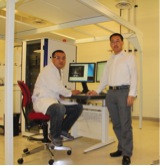
Faxian Xiu, assistant professor of electrical and computer engineering, and his senior postdoctoral fellow Lihong Bao have published successive works on topological insulators in the Nature Journal Scientific Reports. The original article, published on September 18, discussed findings that indicate unique electrical charge carrier transport exists on the surfaces of topological insulator thin films. The most recent paper, published on October 11, delves into his group’s work that experimentally verified the existence of a new topological insulator material—Bi2Se2Te—as predicted from theorists.
As a new class of quantum matter, topological insulators behave like electrical insulators in the bulk interior of a material while being highly conductive along the material’s surface. It has been predicted that surface electrons in these insulators cannot be scattered by defects in the material or non-magnetic impurities, so they produce little or no resistance as they travel. These materials could help eliminate loss in electrical power transmission.
In his latest research, Xiu and his team demonstrated for the first time the topological surface states in an emerging topological insulator called Bi2Se2Te. The research enriches the current family of topological insulators and provides an alternative platform for exploring exotic quantum physical phenomena and low power-dissipation device applications.
Specifically, Xiu and his team uncovered a weak anti-localization effect, or a lower than expected electrical resistance when a small magnetic field is applied to a material due to quantum effects, in Bi2Se2Te by measuring low-temperature charge transport properties. Additionally, their experiments demonstrated very strong oscillations in the electrical resistance of bulk crystals under a varying magnetic field, suggesting that unique carrier transports exist on these surfaces.
Lihong plans to continue the work by building spintronic devices based on Bi2Se2Te that exploit the unique property of high-surface conduction and surface spin states.
Their complete research is included in the paper “Weak Anti-location and Quantum Oscillations of Surface States in Topological Insulator Bi2Se2Te.”
Xiu would like to acknowledge the financial support received from the National Science Foundation under the Award No. 1201883, and the College of Engineering at Iowa State University. The Microelectronics Research Center at Iowa State provided substantial equipment support during the project. This work benefits significantly from the collaboration with the US Department of Energy’s Ames Laboratory, UCLA, and Queensland University.